-
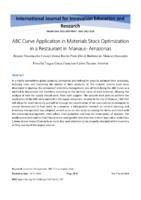 ABC Curve Application in Materials Stock Optimization in a Restaurant in Manaus - Amazonas
ABC Curve Application in Materials Stock Optimization in a Restaurant in Manaus - Amazonas Abstract
In a highly competitive global scenario, companies are looking for ways to optimize their processes,
reducing costs and improving the quality of their products. In this context, several tools were
developed to improve the companies' inventory management, one of them being the ABC Curve as a
method to hierarchize the inventory according to the intrinsic value of each material, allowing the
analysis of how the supply should work. from each supplier. The present work aims to perform the
application of the ABC curve method in the zagaia restaurant, located in the city of Manaus / AM that
will allow the stock hierarchy and will be through the classification of the raw material according to its
annual demand and its Unit price. As a premise, a bibliographic research on content planning and
inventory management was adopted, as well as an on-site study to catalog the items and check with
the restaurant management, their values, their quantities and how the chain works. of supplies. The
results presented confirm that Class A items need greater attention due to their high value, while Class
C items do not impact financially as much, but need attention to be properly allocated within inventory
as they represent the largest volume.
Keyword: Inventory Management, ABC Curve; Supply chain
-
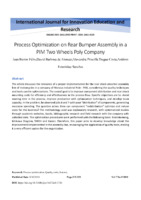 Process Optimization on Rear Bumper Assembly in a PIM Two Wheels Poly Company
Process Optimization on Rear Bumper Assembly in a PIM Two Wheels Poly Company Abstract
The article discusses the relevance of a proper implementation for the rear shock absorber assembly
line of motorcycles in a company of Manaus Industrial Pole - PIM, considering the quality techniques
and tools used in optimizations. The overall goal is to improve component distribution and rear shock
mounting costs for efficiency and effectiveness in the process flow. Specific objectives are to: Avoid
wasting time in the process, improve production with optimization techniques, and develop team
capacity. In the problem, he observed jobs 6 and 7 with poor “distribution” of components, generating
excessive spending. The question arises: How can component “redistribution” optimize and reduce
costs for the business? The methodology used was exploratory research, with systematized studies
through academic websites, books, bibliographic research and field research with the company with
collected data. The optimization procedures were performed with the following tools: Brainstorming,
Ishikawa Diagram, 5W2H and Kaizen. Therefore, this paper aims to develop knowledge about the
improvements implemented in the assembly line, encouraging the application of quality tools, making
it a very efficient option for the organization.
Keyword: Process optimization; Quality tools; Kaizen;
-
 Sustainable Urban Furniture Development Project Reusing Container
Sustainable Urban Furniture Development Project Reusing Container Abstract
The present work seeks the development of urban furniture: bus shelter using sustainable materials.
For a model design to review a methodology of bibliographic research of shelter models Brazil and in
the Municipality of Manaus, and later analysis of data found in our locality seeking to bring the
problem lived daily by the population to select a final structuring of the Project. A bus shelter choice
is tailored to environmental, ergometric and low-cost deployment and maintenance conditions in
relation to existing shelters. A structuring of the project of inputs, a possibility to reuse materials, to
implement clean energy, to design green constructions for the city, to facilitate transportation of
furniture to various places and spaces for PNE.
Keyword: Urban Furniture; Coat of Bus Stop; Sustainability;
-
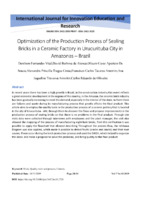 Optimization of the Production Process of Sealing Bricks in a Ceramic Factory in Urucurituba City in Amazonas – Brazil
Optimization of the Production Process of Sealing Bricks in a Ceramic Factory in Urucurituba City in Amazonas – Brazil Abstract
In recent years there has been a high growth in Brazil, in the construction industry this event reflects
a great economic development in the regions of the country, in the Amazon, the ceramic brick industry
has been gradually increasing to meet this demand, especially in the interior of the state. In them there
are failures and waste during its manufacturing process that greatly affects the final product. This
article aims to employ the quality tools in the production process of a ceramic pottery that is located
in the city of Urucurituba - AM, through them to discover the flaws and propose improvements in the
production process of sealing bricks so that there is no problems in the final product. Through site
visits data were collected through interviews with employees and the plant manager, the visit also
allowed the mapping of the process of manufacturing eight-hole bricks, from this verification it was
possible to apply the flowchart that allowed describing Throughout the process flow, the Ishikawa
Diagram was also applied, which made it possible to detect faults (cracks and cracks) and their root
causes. These occur during the brick production process and used the 5W2H, which helped to organize
the ideas. and make a proposal to solve the problems, and bring quality to the final product
Keyword: Brick; Quality tools and process; Ceramic
-
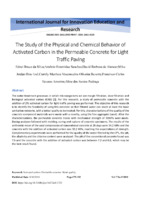 The Study of the Physical and Chemical Behavior of Activated Carbon in the Permeable Concrete for Light Traffic Paving
The Study of the Physical and Chemical Behavior of Activated Carbon in the Permeable Concrete for Light Traffic Paving Abstract
The water treatment processes in which microorganisms act are margin filtration, slow filtration and
biological activated carbon (CAB) [2]. For this research, a study of permeable concrete with the
addition of 2% activated carbon for light traffic paving was performed. The objective of this research
is to identify the feasibility of using this concrete so that filtered water can reach at least the basic
sanitation networks, with a better quality to be treated. For this, characterizations of the quality of the
concrete component materials were made with a novelty, using the fine aggregate (sand). After the
characterizations, the permeable concrete traces with mechanical strength of 30MPa were made.
Dosing analyzes followed with molding, curing and rupture of concrete specimens. The results of the
arithmetic mean of the axial compression of conventional concrete at 28 days were 34.2 MPa and the
concrete with the addition of activated carbon was 32.2 MPa, reaching the expectations of strength.
Complementary experiments were performed for the quality of the water filtered by the CP's, the pH,
the alkalinity and the chlorine content were analyzed. The pH of the conventional concrete found was
7.6 and the concrete with the addition of activated carbon was between 7.2 and 6.8, which may be
the best result found
Keyword: Activated carbon. Permeable concrete. Water quality.
-
 Reverse Aftermarket Logistics in E-Commerce a Case Study in a Manaus Microenterprise
Reverse Aftermarket Logistics in E-Commerce a Case Study in a Manaus Microenterprise Abstract
Logistics are of great importance in a globalized market. Supply chains are always in global
competition, involving multiple countries and multiple companies. Direct Logistics is the process by
which the products pass from the place of origin of the raw material to the final consumer. Aftermarket
Reverse Logistics is required to resolve issues after products reach their final destination, and before
consumption, but can also occur before, as is the case with e-commerce, due to problems in receiving
ordering, packaging and shipping. Companies must always be prepared to respond quickly to this
demand. Strict control of the entire process from order receipt to delivery to the consumer is required
and this process needs to be integrated in real time. In the case study, of the orders sent, only about
3% present some problem, all of which are solved quickly. This result is the way the company handles
each order, in constant communication with the customer, clarifying doubts and solving problems
quickly. The result is the low return rate compared to other e-commerce companies, and the 100%
resolution of cases, always valuing the satisfaction of their customers.
Keyword: Logistics; Reverse logistic; Reverse Aftermarket Logistics;
-
 Talud Stabilization of Bird House Residential in Manaus City
Talud Stabilization of Bird House Residential in Manaus City Abstract
Slope stabilization techniques have been increasingly used in the field, mainly due to high market
values for land in large urban centers. With this, the technical feasibility study guarantees the
application of the best solution for each case. From this context, we sought to verify the best method
of containment by means of a case study according to the parameters of soil resistance, cohesion and
angle of friction at the residence Morada dos Pássaros in Manaus - AM. The methodology used was of
an exploratory nature with a case study, where in the first phase the topographic survey of the study
area was carried out. In the second phase, it was sought to plan the location of the holes, according to
ABNT NBR 8036 (1983). for the accomplishment and technical follow-up of the investigation of the soil
in the place by means of the test of percussion to the percussion - SPT and in the 3º phase was
characterized by means of physical and mechanical laboratory test with the collection of material.
Considering the collected data, it is noticed that the soil is with 3% of plasticity, concluding that a soil
with plasticity below 7% loses the capacity to be molded and to become brittle. Therefore, it is
concluded that the best technique to be used is geosynthetics, both in cost and in soil absorption, due
to the feasibility of redistribution of stresses and slope deformations.
Keyword: Stabilization; Slope; Technical viability
-
 Urban Waterway Logistics
Urban Waterway Logistics Abstract
Although Manaus has a favorable geography for waterway transport and is not fully utilized. The
objective of this research is to present a proposal for the implementation of an Urban Waterway Modal
on the banks of the Rio Negro that surrounds the city of Manaus, aiming to favor the population that
needs transportation to get from one point to another, and thus guarantee the decreased congestion
on city streets. This project will focus on field and bibliographic research, the technical and economic
feasibility also making a cost survey, and a commuting time survey of public transport users, enabling
a new solution to the means of transportation in the city.
Keyword: Modal, Transportation, Waterway
-
 MANAGEMENT INTEGRATION PLAN IN A CIVIL CONSTRUCTION COMPANY
MANAGEMENT INTEGRATION PLAN IN A CIVIL CONSTRUCTION COMPANY Currently, the subject of Project Management has received great evidence in the business world
due to the competition dispute and increasing competitiveness, which makes the business
organizations present solutions more quickly and efficiently to external stimuli, in civil
construction has been growing the concept of project management with the purpose of having
term, quality, profit in the services rendered. With this vision, several tools, methodologies and
even organizational entities have been developed with the purpose of ensuring that the projects
achieve the expected results. Thus, with several processes and tasks, the project integration
management area has high professional relevance, ranging from the elaboration of the scope,
through the monitoring and control of the project, and ends in the organization of the final
materials, as well as in the lessons learned. Thus, the article will present a project integration
plan developed by a construction service provider, the integration plan aims to meet Project
management, Time management, Cost management, Quality management and Human
resources and their respective controls.
Keywords: Project Management; Integration; Management.
-
 USE OF INDIVIDUAL PROTECTION EQUIPMENT IN CIVIL CONSTRUCTION
USE OF INDIVIDUAL PROTECTION EQUIPMENT IN CIVIL CONSTRUCTION The use of Personal protective equipment (PPE) is extremely essential for any activity that is
prone to occupational hazards and / or illnesses that could threaten the safety and health of the
worker. The construction market has grown abundantly in recent years, and consequently the
risk of accidents in this work environment as well. There are several reasons for this growing
increase in accidents at work, among them is the Contracting Company that does not provide
correctly the equipment of personal protection for its employees and the lack of commitment
and interest of the employees in the use of protective equipment. The objective of this study is
to evaluate the use of individual protection equipment in the construction company in a given
service rendering, which includes the construction of reinforced concrete wall and drainage
network installation, observing the methods used for adhesion and control of the use of PPE.
Although the work is short-term and the accident risk is high, in the course of the work up to
the date of delivery, a satisfactory result was obtained both for the Company and for the
employees involved in the activities, as it had no accident of job.
Keywords: Individual Protection Equipment; Contributors; Accident.
-
 IMPORTANCE OF WORK SAFETY IN PROFESSIONAL QUALIFICATION COURSES: REDUCTION IN LABOR ACCIDENT RATE
IMPORTANCE OF WORK SAFETY IN PROFESSIONAL QUALIFICATION COURSES: REDUCTION IN LABOR ACCIDENT RATE The use of Personal Protective Equipment (PPE) is a method of preventive action against
accidents at work, with a purpose to preserve the individual from the threats to his individual
health and safety. The objective of this work is to elucidate the success of the methodology
applied in the student body of the SENAI Demóstenes Travessa School, regarding the use of
PPE in professional qualification courses, preventing and raising awareness among students
seeking knowledge to apply in the labor market or in their personal lives, I try in view that, the
school is focused on the follow-up of construction, one of the sectors that most accidents occur.
Keywords: PPE; Workplace safety; Construction; Teaching, Professional Qualification.
-
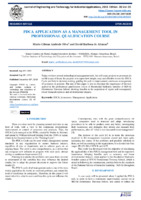 PDCA APPLICATION AS A MANAGEMENT TOOL IN PROFESSIONAL QUALIFICATION COURSE
PDCA APPLICATION AS A MANAGEMENT TOOL IN PROFESSIONAL QUALIFICATION COURSE Today we have several technological management tools, but still many projects or processes do
not fit in any of them, the purpose is to report how simple, easy and effective to use the PDCA
Cycle and help in decision making, guiding the path to improvement continuous management
of processes or projects. The aim of this paper is also to elucidate the importance of the tool
applied in the professional qualification course of Residential Hydraulic Installer of SENAI
Demóstenes Travessa School, showing benefits in the acquisition of inputs and consequently
lower financial expenses and environmental impacts.
Keywords: PDCA, Economics, Management, Application
-
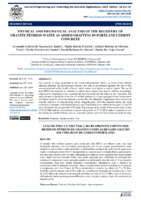 RCH ARTICLE OPEN ACCESS PHYSICAL AND MECHANICAL ANALYSIS OF THE RECOVERY OF GRANITE PÉTREOS WASTE AS ADDED GRAFTING IN PORTLAND CEMENT CONCRETE
RCH ARTICLE OPEN ACCESS PHYSICAL AND MECHANICAL ANALYSIS OF THE RECOVERY OF GRANITE PÉTREOS WASTE AS ADDED GRAFTING IN PORTLAND CEMENT CONCRETE The increase in waste generated by the construction industry (RCC) in recent years, without
adequate disposal, has accumulated concerns not only to government agencies but also to the
environment and public health in Brazil, which varies from region to region. region. The use of
these RCCs incorporated in concrete to reduce these clusters has been a solution increasingly
employed by companies in this segment that are concerned with the future of our. Therefore, this
study presents a feasibility in the use of marbled residues as a large aggregate in total replacement
of crushed stone No. 0 in conventional concrete. For this, laboratory experiments were carried out
with the objective of characterizing all the materials used. After the characterization, the axial
compressive strengths of the hardened and cured Test Bodies were verified in the ages of 7 and 28
days, divided in two groups with 4 CPs each. The average of the results of the residue with a value
of 25.02 MPa and the conventional concrete with gravel, of 27.32 MPa, makes it possible to use
the residue for small buildings such as: sidewalks, gutters and small non-structural slabs bearing.
Keywords: Concrete. Granite residue. Use.
-
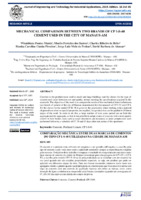 MECHANICAL COMPARISON BETWEEN TWO BRANDS OF CP I-S-40 CEMENT USED IN THE CITY OF MANAUS-AM
MECHANICAL COMPARISON BETWEEN TWO BRANDS OF CP I-S-40 CEMENT USED IN THE CITY OF MANAUS-AM Concrete is the product most used in small and large buildings and the choice for the type of
cement used varies between cost and quality, always meeting the specifications required by the
standards. The objective of this work is to compare the results of the mechanical behavior between
two brands of cement of the city of Manaus denominated for this research of CP I-T1 and CP IT2, the choice for the model CP IS-40 is given by the practicality when working with a material
of general use when no special properties are required, ie a product that can be applied in different
stages of the work. In order to do this, a large number of tests were carried out on both the
aggregate and the aggregate, so that it was possible to adopt a trace of concrete with a strict quality
control in both brands, tests such as water absorption and resistance to axial compression were
performed following a schedule of 07, 28 and 63 days after wet curing of the specimens.
Keywords: Concrete, Portland Cement, CP I-S40.
-
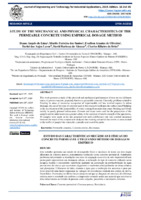 STUDY OF THE MECHANICAL AND PHYSICAL CHARACTERISTICS OF THE PERMEABLE CONCRETE USING EMPIRICAL DOSAGE METHOD
STUDY OF THE MECHANICAL AND PHYSICAL CHARACTERISTICS OF THE PERMEABLE CONCRETE USING EMPIRICAL DOSAGE METHOD This work presents a study of the physical and mechanical performance of tests on two different
traces of porous concrete, popularly known as permeable concrete. Currently problems related to
flooding in areas of excessive occupation of impermeable soil has worried experts in urban
drainage, the use of the type of concrete used in this research facilitates the surface runoff helping
in the acceleration of the permeability of water coming from rains that cause flooding and floods
mainly in poorly planned urban areas. Cement and water were used for the preparation of the
samples and in order to ensure a greater safety in the variation of tensile strength of the specimens,
10 samples were made in the last proposed test until a difference rate was reached minimum
between the result of the compression analyzes thus making a material that resists to areas related
to the traffic of people like sidewalks, catwalks and even bike paths.
Keywords: Permeable concrete, Concrete porous, Resistance
-
 The use of Drywall in inner vertical seals: advantages and disadvantages against the common masonry system in Brazil
The use of Drywall in inner vertical seals: advantages and disadvantages against the common masonry system in Brazil In the construction industry in Brazil the masonry system is the most used. However, a market that
has already settled in Europe and North America has been the Drywall system for building vertical
seals built into buildings. Such a system shows itself quite satisfactory, fulfilling its function
properly. Thus, the present study has as its general objective: Understand the benefits and features of
the Drywall system in Brazil. So, your specific goals focus on: To know the productive system of
application of plasterboard plaster plates (CGA); Identify the differences between the use of the
common masonry system and the Plasterboard Gypsum sheet System (CGA) in constructions; E
Check the efficacy of the use of plasterboard plaster plates (CGA) in buildings in front of the
common masonry system. As a methodological path, the study is made up of theoretical knowledge
on the subject, thus a survey of theoretical reference was carried out based on the bibliographic and
documentary methods. It is Verificouu that the Drywall has been used in Brazil mainly in the
commercial construction business, i.e. in shops, offices, etc., because it is a relatively new method in
Brazil, it is still not widely used in residential constructions. However, in the construction process
the use of the Drywall system is very favorable to the market, in view of its practicality, speed in the
execution of processes and reduction of the financial costs of the work.
Keywords: Drywall; Masonry; Benefits.
-
 Gray water reuse system from air conditioners for non-potable purposes: case study applied at the Secretary of State of Finance - SEFAZ headquarters building in the city of Manaus-Am
Gray water reuse system from air conditioners for non-potable purposes: case study applied at the Secretary of State of Finance - SEFAZ headquarters building in the city of Manaus-Am Due to the abundance of waters in the North region, the rational use of this resource goes unnoticed
by the population. This situation occurs because the population is growing disorderly and each year
as a consequence much of the existing fresh water is being contaminated by industrial, domestic and
other activities. To do this, it must be used in a sustainable way so that it can meet the needs,
guaranteeing the capacity to serve future generations. Faced with this, the question arises: Will
condensed gray water between different thermal capacities of the air conditioners contribute one day
to the rational reuse of sidewalks and gardens? Therefore, the objective is to analyze the economical
and constructive viability of the use of gray water coming from air conditioners and to design a
collection and storage system for non-potable purposes applied to the irrigation of the vegetation of
the building, cleaning pants and sewage. Applied in the secretary of state of the farm - SEFAZ
headquarters building in the city Manaus - AM. With the result, it is observed that the reuse of
condensed water from the air-conditioning system, since a monthly production of 4,332.00 L per
month of water from these condensers is made possible, it is reasonable to install a system of
abstraction.
Keywords: Water reuse, sustainable, air conditioning.
-
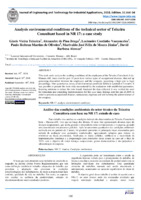 ANALYSIS ENVIRONMENTAL CONDITIONS OF THE TECHNICAL SECTOR OF TEIXEIRA CONSULTANT BASED IN NR 17: A CASE STUDY
ANALYSIS ENVIRONMENTAL CONDITIONS OF THE TECHNICAL SECTOR OF TEIXEIRA CONSULTANT BASED IN NR 17: A CASE STUDY This work seeks analyze the working conditions of the employees of the Teixeira Consultoria LtdaManaus-AM, since over the past 10 years have various types of occupational diseases, that end up
generating discomfort between the employees and the company, generating a high cost in legal
proceedings. After quantitative survey of environmental conditions heldin in a period of 2 months, It
was possible to present the main risks encountered by the evaluation with established parameters,
featuring solutions to reduce the risks found. Analyzed the data collected, It was verified the need
for immediate and scheduling implementations for this case study findings until the end of 2019, in
order to prevent occupational diseases, unnecessary expenses and not harming the administration of
the company.
Keywords: NR 17. analyze, environmental conditions
-
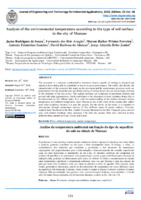 Analysis of the environmental temperature according to the type of soil surface in the city of Manaus
Analysis of the environmental temperature according to the type of soil surface in the city of Manaus The pavement is a structure conditioned to numerous factors capable of altering its physical and
chemical form, being able to contribute or not to its good performance. The traffic, the climate, the
characteristics of the materials that make up the pavement and the maintenance processes used, are
preponderant for the determination and dimensioning of surface layers that are increasingly resistant
to the elements of the day-to-day. The asphalt mixtures are composed of petroleum residues and
present with dark pigmentation, which contributes to the absorption of solar radiation, being able to
be determined by the Albedo index. It is valid the understanding of the relation between surface
temperature and ambient temperature, since Manaus is one of the cities of the country that suffers
most solar incidence, because it is near the equator. For the above, in this study, it is intended to
demonstrate through temperature surveys in five different types of paved surfaces: Concrete,
Asphalt Sand Machined to the Hot, Asphalt Concrete Machined to the Hot. Unpaved: grass and soil
area, with distinct locations, these measures 1.5m from the ground. Data were collected at three
different times, namely at 8 am, 12 a.m. and 5 p.m.
Keywords: Floor, ambient temperature, surface temperature.
-
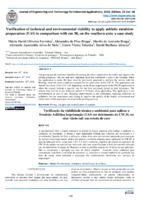 Verification of technical and environmental viability to apply ashletic emulsion preparation (EAI) in comparison with cm 30, on the southern axis: a case study
Verification of technical and environmental viability to apply ashletic emulsion preparation (EAI) in comparison with cm 30, on the southern axis: a case study The paving has the structural function of resisting the forces imposed by the traffic and improve the
rolling conditions. The last and most important layer that constitutes a floor is the flooring. When
the application is made, the base must be previously prepared to perform the service with the
Priming, under the same conditions required for the application of the CM 30. The application rate
should vary from 1.0 to 1.5 L / m², depending on the design requirement of the CM 30 application or
when the experts indicate a specific rate for the base previously tested in their laboratory. The
release time will be in the minimum period of 24 hours of its application. The application is not
recommended in case of rain. Bringing improvements to the community, reducing emissions of
pollutants into the atmosphere and aiming to improve the quality of the health, environment and
safety items of the employees involved in the priming services.
Keywords: Paving, emulpen and emulsification of asphalts.
-
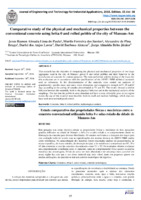 Comparative study of the physical and mechanical properties between the conventional concrete using brita 0 and rolled pebble of the city of Manaus-Am
Comparative study of the physical and mechanical properties between the conventional concrete using brita 0 and rolled pebble of the city of Manaus-Am This research has the objective of comparing the physical and mechanical properties of two large
aggregates used in the city of Manaus: gravel 0 and rolled pebbles and their behavior in the
manufacture of concrete for various purposes. The tests performed and the dosing of the traces for
this evaluation are in accordance with the specifications of the ABNT / NBR technical standards
used as references. In the characterization of the materials were carried out analyzes of
granulometry, specific mass, unit mass, water absorption, and compressive strength at 07, 28 and 63
days according to the curing of samples denominated as T1 and T2. The results showed a similar
behavior between the materials, both in the physical behavior and in the mechanical analysis of the
samplings. The fact that the pebble is more abundant and have a more affordable price in our region
makes the use of this material more feasible, both in small and medium buildings, which does not
have such strict technological control.
Keywords: Concrete, brita 0, rolled pebble, technological control
-
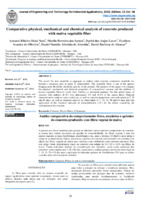 Comparative physical, mechanical and chemical analysis of concrete produced with malva vegetable fiber
Comparative physical, mechanical and chemical analysis of concrete produced with malva vegetable fiber The search for new materials to aggregate or replace other concrete component materials has
become a necessary race in terms of sustainability. The vegetable fibers is one of the options
bringing more flexibility, durability and etc. to the product. The purpose of this paper is to compare
the physical, mechanical and chemical properties of conventional concrete and the addition of
mauve vegetable fibers to verify their viability as structural concrete. For this article traces of
concrete with addition of 0.3 were determined; 0.5 and 11.0% of the mauve fibers. Material
characterization analyzes were carried out, as well as concrete preparation, cure and rupture at 7, 28
and 63 days, as well as chemical analysis by observation of 7, 15, 31, 50 and 93 days after the
application of the chemical indicator of phenolphthalein (1%) for the effects caused by the
carbonation of the concrete.
Keywords: Concrete, Mauve Fibers, Cabonation.
-
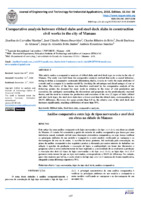 Comparative analysis between ribbed slabs and steel deck slabs in construction civil works in the city of Manaus
Comparative analysis between ribbed slabs and steel deck slabs in construction civil works in the city of Manaus This article makes a comparative analysis of ribbed slabs and steel deck type, in works in the city of
Manaus. The study was built from the comparative analysis method that seeks a causal inference,
trying to define a comparative systematic illustration, that is, it seeks to verify the main attributes of
a model and to compare it to another model by checking the advantages and disadvantages of one or
the other. The choice of the theme was therefore motivated by the comparative analysis of the
following points: the demand for more work in relation to the issue of slab production and
execution; the ambiguity surrounding the discussions and proposals on the predominantly regional
theme; and the need to evaluate the production and execution of the two (2) types of slabs (ribbed
and steel deck type). the steel deck slabs have a lower cost than the ribbed slabs, corresponding to a
20.0% difference. However, for spans greater than 6.0 m, the relative cost of the steel deck slab
increases significantly, reaching a difference of more than 70%.
Keywords: Ribbed slabs, Steel deck slab, comparative analysis.
-
 BIM in bidding public works
BIM in bidding public works Does the lack of administration in public works foster a drain of public resources that has expanded
into society, generating a political, economic and social crisis Having its legal principle in Law
8.666/93, which establishes rules to establish the obligation for biddings with the inclusion of the
BIM (Building Information Model) system that deliberates the improvement in the processes and
management of projects that underpin the development of Brazil. However, the objective is to
describe the process of implementation of the bidding process from the BIM platform and to cite its
importance in relation to the conventional method of public bidding. The research method used
consisted of a case study with identification of the methods of implementation of BIM in public
works biddings establishing links between social, economic and legal instances and a comparative
study between bibliographic researches based on scientific publications, articles, specific laws,
jurisprudence, renowned doctrines of referential authors and the Constitution of the Brazilian
Federative Republic (CRFB) and a case study. The results point out obstacles that the system has a
process failure, but which are overcome, given the diffusion of information and communication
between the servers that direct the professionals to use the platform with legal restriction when
analyzing the object and choosing criteria.
Keywords: Bids, BIM - Building Information Model, Public works.
-
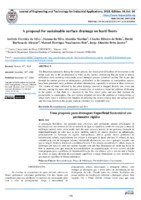 A proposal for sustainable surface drainage on hard floors
A proposal for sustainable surface drainage on hard floors The Brazilian population, during the wetter periods, has faced great difficulties of locomotion in the
urban roads due to the accumulation of water on the surface, considering that the areas of natural
infiltration (soil) are being increasingly scarce through a process called soil sealing. This is due also
through the intense process of urbanization, particularly in the formation of metropolitan regions,
have been generated many problems of urban infrastructure, especially in relation to drain rainwater.
The volume of water collected by the urban drainage network is dropped directly into rivers and
streams, causing the water table decrease considerably. A solution is found the addition of thinning
in the gutters so that there is a decrease in the flow sluice gates, and also that increase the
permeability or renaturation. The new system adopted will solve the problem of waterproofing of
urban roads, since it will have the function of collecting the waters coming from the surface runoff
and throwing directly to the ground, making a balance in a sustainable way.
Keywords: Renaturalization, permeability and flow.
 ABC Curve Application in Materials Stock Optimization in a Restaurant in Manaus - Amazonas Abstract In a highly competitive global scenario, companies are looking for ways to optimize their processes, reducing costs and improving the quality of their products. In this context, several tools were developed to improve the companies' inventory management, one of them being the ABC Curve as a method to hierarchize the inventory according to the intrinsic value of each material, allowing the analysis of how the supply should work. from each supplier. The present work aims to perform the application of the ABC curve method in the zagaia restaurant, located in the city of Manaus / AM that will allow the stock hierarchy and will be through the classification of the raw material according to its annual demand and its Unit price. As a premise, a bibliographic research on content planning and inventory management was adopted, as well as an on-site study to catalog the items and check with the restaurant management, their values, their quantities and how the chain works. of supplies. The results presented confirm that Class A items need greater attention due to their high value, while Class C items do not impact financially as much, but need attention to be properly allocated within inventory as they represent the largest volume. Keyword: Inventory Management, ABC Curve; Supply chain
ABC Curve Application in Materials Stock Optimization in a Restaurant in Manaus - Amazonas Abstract In a highly competitive global scenario, companies are looking for ways to optimize their processes, reducing costs and improving the quality of their products. In this context, several tools were developed to improve the companies' inventory management, one of them being the ABC Curve as a method to hierarchize the inventory according to the intrinsic value of each material, allowing the analysis of how the supply should work. from each supplier. The present work aims to perform the application of the ABC curve method in the zagaia restaurant, located in the city of Manaus / AM that will allow the stock hierarchy and will be through the classification of the raw material according to its annual demand and its Unit price. As a premise, a bibliographic research on content planning and inventory management was adopted, as well as an on-site study to catalog the items and check with the restaurant management, their values, their quantities and how the chain works. of supplies. The results presented confirm that Class A items need greater attention due to their high value, while Class C items do not impact financially as much, but need attention to be properly allocated within inventory as they represent the largest volume. Keyword: Inventory Management, ABC Curve; Supply chain Process Optimization on Rear Bumper Assembly in a PIM Two Wheels Poly Company Abstract The article discusses the relevance of a proper implementation for the rear shock absorber assembly line of motorcycles in a company of Manaus Industrial Pole - PIM, considering the quality techniques and tools used in optimizations. The overall goal is to improve component distribution and rear shock mounting costs for efficiency and effectiveness in the process flow. Specific objectives are to: Avoid wasting time in the process, improve production with optimization techniques, and develop team capacity. In the problem, he observed jobs 6 and 7 with poor “distribution” of components, generating excessive spending. The question arises: How can component “redistribution” optimize and reduce costs for the business? The methodology used was exploratory research, with systematized studies through academic websites, books, bibliographic research and field research with the company with collected data. The optimization procedures were performed with the following tools: Brainstorming, Ishikawa Diagram, 5W2H and Kaizen. Therefore, this paper aims to develop knowledge about the improvements implemented in the assembly line, encouraging the application of quality tools, making it a very efficient option for the organization. Keyword: Process optimization; Quality tools; Kaizen;
Process Optimization on Rear Bumper Assembly in a PIM Two Wheels Poly Company Abstract The article discusses the relevance of a proper implementation for the rear shock absorber assembly line of motorcycles in a company of Manaus Industrial Pole - PIM, considering the quality techniques and tools used in optimizations. The overall goal is to improve component distribution and rear shock mounting costs for efficiency and effectiveness in the process flow. Specific objectives are to: Avoid wasting time in the process, improve production with optimization techniques, and develop team capacity. In the problem, he observed jobs 6 and 7 with poor “distribution” of components, generating excessive spending. The question arises: How can component “redistribution” optimize and reduce costs for the business? The methodology used was exploratory research, with systematized studies through academic websites, books, bibliographic research and field research with the company with collected data. The optimization procedures were performed with the following tools: Brainstorming, Ishikawa Diagram, 5W2H and Kaizen. Therefore, this paper aims to develop knowledge about the improvements implemented in the assembly line, encouraging the application of quality tools, making it a very efficient option for the organization. Keyword: Process optimization; Quality tools; Kaizen; Sustainable Urban Furniture Development Project Reusing Container Abstract The present work seeks the development of urban furniture: bus shelter using sustainable materials. For a model design to review a methodology of bibliographic research of shelter models Brazil and in the Municipality of Manaus, and later analysis of data found in our locality seeking to bring the problem lived daily by the population to select a final structuring of the Project. A bus shelter choice is tailored to environmental, ergometric and low-cost deployment and maintenance conditions in relation to existing shelters. A structuring of the project of inputs, a possibility to reuse materials, to implement clean energy, to design green constructions for the city, to facilitate transportation of furniture to various places and spaces for PNE. Keyword: Urban Furniture; Coat of Bus Stop; Sustainability;
Sustainable Urban Furniture Development Project Reusing Container Abstract The present work seeks the development of urban furniture: bus shelter using sustainable materials. For a model design to review a methodology of bibliographic research of shelter models Brazil and in the Municipality of Manaus, and later analysis of data found in our locality seeking to bring the problem lived daily by the population to select a final structuring of the Project. A bus shelter choice is tailored to environmental, ergometric and low-cost deployment and maintenance conditions in relation to existing shelters. A structuring of the project of inputs, a possibility to reuse materials, to implement clean energy, to design green constructions for the city, to facilitate transportation of furniture to various places and spaces for PNE. Keyword: Urban Furniture; Coat of Bus Stop; Sustainability; Optimization of the Production Process of Sealing Bricks in a Ceramic Factory in Urucurituba City in Amazonas – Brazil Abstract In recent years there has been a high growth in Brazil, in the construction industry this event reflects a great economic development in the regions of the country, in the Amazon, the ceramic brick industry has been gradually increasing to meet this demand, especially in the interior of the state. In them there are failures and waste during its manufacturing process that greatly affects the final product. This article aims to employ the quality tools in the production process of a ceramic pottery that is located in the city of Urucurituba - AM, through them to discover the flaws and propose improvements in the production process of sealing bricks so that there is no problems in the final product. Through site visits data were collected through interviews with employees and the plant manager, the visit also allowed the mapping of the process of manufacturing eight-hole bricks, from this verification it was possible to apply the flowchart that allowed describing Throughout the process flow, the Ishikawa Diagram was also applied, which made it possible to detect faults (cracks and cracks) and their root causes. These occur during the brick production process and used the 5W2H, which helped to organize the ideas. and make a proposal to solve the problems, and bring quality to the final product Keyword: Brick; Quality tools and process; Ceramic
Optimization of the Production Process of Sealing Bricks in a Ceramic Factory in Urucurituba City in Amazonas – Brazil Abstract In recent years there has been a high growth in Brazil, in the construction industry this event reflects a great economic development in the regions of the country, in the Amazon, the ceramic brick industry has been gradually increasing to meet this demand, especially in the interior of the state. In them there are failures and waste during its manufacturing process that greatly affects the final product. This article aims to employ the quality tools in the production process of a ceramic pottery that is located in the city of Urucurituba - AM, through them to discover the flaws and propose improvements in the production process of sealing bricks so that there is no problems in the final product. Through site visits data were collected through interviews with employees and the plant manager, the visit also allowed the mapping of the process of manufacturing eight-hole bricks, from this verification it was possible to apply the flowchart that allowed describing Throughout the process flow, the Ishikawa Diagram was also applied, which made it possible to detect faults (cracks and cracks) and their root causes. These occur during the brick production process and used the 5W2H, which helped to organize the ideas. and make a proposal to solve the problems, and bring quality to the final product Keyword: Brick; Quality tools and process; Ceramic The Study of the Physical and Chemical Behavior of Activated Carbon in the Permeable Concrete for Light Traffic Paving Abstract The water treatment processes in which microorganisms act are margin filtration, slow filtration and biological activated carbon (CAB) [2]. For this research, a study of permeable concrete with the addition of 2% activated carbon for light traffic paving was performed. The objective of this research is to identify the feasibility of using this concrete so that filtered water can reach at least the basic sanitation networks, with a better quality to be treated. For this, characterizations of the quality of the concrete component materials were made with a novelty, using the fine aggregate (sand). After the characterizations, the permeable concrete traces with mechanical strength of 30MPa were made. Dosing analyzes followed with molding, curing and rupture of concrete specimens. The results of the arithmetic mean of the axial compression of conventional concrete at 28 days were 34.2 MPa and the concrete with the addition of activated carbon was 32.2 MPa, reaching the expectations of strength. Complementary experiments were performed for the quality of the water filtered by the CP's, the pH, the alkalinity and the chlorine content were analyzed. The pH of the conventional concrete found was 7.6 and the concrete with the addition of activated carbon was between 7.2 and 6.8, which may be the best result found Keyword: Activated carbon. Permeable concrete. Water quality.
The Study of the Physical and Chemical Behavior of Activated Carbon in the Permeable Concrete for Light Traffic Paving Abstract The water treatment processes in which microorganisms act are margin filtration, slow filtration and biological activated carbon (CAB) [2]. For this research, a study of permeable concrete with the addition of 2% activated carbon for light traffic paving was performed. The objective of this research is to identify the feasibility of using this concrete so that filtered water can reach at least the basic sanitation networks, with a better quality to be treated. For this, characterizations of the quality of the concrete component materials were made with a novelty, using the fine aggregate (sand). After the characterizations, the permeable concrete traces with mechanical strength of 30MPa were made. Dosing analyzes followed with molding, curing and rupture of concrete specimens. The results of the arithmetic mean of the axial compression of conventional concrete at 28 days were 34.2 MPa and the concrete with the addition of activated carbon was 32.2 MPa, reaching the expectations of strength. Complementary experiments were performed for the quality of the water filtered by the CP's, the pH, the alkalinity and the chlorine content were analyzed. The pH of the conventional concrete found was 7.6 and the concrete with the addition of activated carbon was between 7.2 and 6.8, which may be the best result found Keyword: Activated carbon. Permeable concrete. Water quality. Reverse Aftermarket Logistics in E-Commerce a Case Study in a Manaus Microenterprise Abstract Logistics are of great importance in a globalized market. Supply chains are always in global competition, involving multiple countries and multiple companies. Direct Logistics is the process by which the products pass from the place of origin of the raw material to the final consumer. Aftermarket Reverse Logistics is required to resolve issues after products reach their final destination, and before consumption, but can also occur before, as is the case with e-commerce, due to problems in receiving ordering, packaging and shipping. Companies must always be prepared to respond quickly to this demand. Strict control of the entire process from order receipt to delivery to the consumer is required and this process needs to be integrated in real time. In the case study, of the orders sent, only about 3% present some problem, all of which are solved quickly. This result is the way the company handles each order, in constant communication with the customer, clarifying doubts and solving problems quickly. The result is the low return rate compared to other e-commerce companies, and the 100% resolution of cases, always valuing the satisfaction of their customers. Keyword: Logistics; Reverse logistic; Reverse Aftermarket Logistics;
Reverse Aftermarket Logistics in E-Commerce a Case Study in a Manaus Microenterprise Abstract Logistics are of great importance in a globalized market. Supply chains are always in global competition, involving multiple countries and multiple companies. Direct Logistics is the process by which the products pass from the place of origin of the raw material to the final consumer. Aftermarket Reverse Logistics is required to resolve issues after products reach their final destination, and before consumption, but can also occur before, as is the case with e-commerce, due to problems in receiving ordering, packaging and shipping. Companies must always be prepared to respond quickly to this demand. Strict control of the entire process from order receipt to delivery to the consumer is required and this process needs to be integrated in real time. In the case study, of the orders sent, only about 3% present some problem, all of which are solved quickly. This result is the way the company handles each order, in constant communication with the customer, clarifying doubts and solving problems quickly. The result is the low return rate compared to other e-commerce companies, and the 100% resolution of cases, always valuing the satisfaction of their customers. Keyword: Logistics; Reverse logistic; Reverse Aftermarket Logistics; Talud Stabilization of Bird House Residential in Manaus City Abstract Slope stabilization techniques have been increasingly used in the field, mainly due to high market values for land in large urban centers. With this, the technical feasibility study guarantees the application of the best solution for each case. From this context, we sought to verify the best method of containment by means of a case study according to the parameters of soil resistance, cohesion and angle of friction at the residence Morada dos Pássaros in Manaus - AM. The methodology used was of an exploratory nature with a case study, where in the first phase the topographic survey of the study area was carried out. In the second phase, it was sought to plan the location of the holes, according to ABNT NBR 8036 (1983). for the accomplishment and technical follow-up of the investigation of the soil in the place by means of the test of percussion to the percussion - SPT and in the 3º phase was characterized by means of physical and mechanical laboratory test with the collection of material. Considering the collected data, it is noticed that the soil is with 3% of plasticity, concluding that a soil with plasticity below 7% loses the capacity to be molded and to become brittle. Therefore, it is concluded that the best technique to be used is geosynthetics, both in cost and in soil absorption, due to the feasibility of redistribution of stresses and slope deformations. Keyword: Stabilization; Slope; Technical viability
Talud Stabilization of Bird House Residential in Manaus City Abstract Slope stabilization techniques have been increasingly used in the field, mainly due to high market values for land in large urban centers. With this, the technical feasibility study guarantees the application of the best solution for each case. From this context, we sought to verify the best method of containment by means of a case study according to the parameters of soil resistance, cohesion and angle of friction at the residence Morada dos Pássaros in Manaus - AM. The methodology used was of an exploratory nature with a case study, where in the first phase the topographic survey of the study area was carried out. In the second phase, it was sought to plan the location of the holes, according to ABNT NBR 8036 (1983). for the accomplishment and technical follow-up of the investigation of the soil in the place by means of the test of percussion to the percussion - SPT and in the 3º phase was characterized by means of physical and mechanical laboratory test with the collection of material. Considering the collected data, it is noticed that the soil is with 3% of plasticity, concluding that a soil with plasticity below 7% loses the capacity to be molded and to become brittle. Therefore, it is concluded that the best technique to be used is geosynthetics, both in cost and in soil absorption, due to the feasibility of redistribution of stresses and slope deformations. Keyword: Stabilization; Slope; Technical viability Urban Waterway Logistics Abstract Although Manaus has a favorable geography for waterway transport and is not fully utilized. The objective of this research is to present a proposal for the implementation of an Urban Waterway Modal on the banks of the Rio Negro that surrounds the city of Manaus, aiming to favor the population that needs transportation to get from one point to another, and thus guarantee the decreased congestion on city streets. This project will focus on field and bibliographic research, the technical and economic feasibility also making a cost survey, and a commuting time survey of public transport users, enabling a new solution to the means of transportation in the city. Keyword: Modal, Transportation, Waterway
Urban Waterway Logistics Abstract Although Manaus has a favorable geography for waterway transport and is not fully utilized. The objective of this research is to present a proposal for the implementation of an Urban Waterway Modal on the banks of the Rio Negro that surrounds the city of Manaus, aiming to favor the population that needs transportation to get from one point to another, and thus guarantee the decreased congestion on city streets. This project will focus on field and bibliographic research, the technical and economic feasibility also making a cost survey, and a commuting time survey of public transport users, enabling a new solution to the means of transportation in the city. Keyword: Modal, Transportation, Waterway MANAGEMENT INTEGRATION PLAN IN A CIVIL CONSTRUCTION COMPANY Currently, the subject of Project Management has received great evidence in the business world due to the competition dispute and increasing competitiveness, which makes the business organizations present solutions more quickly and efficiently to external stimuli, in civil construction has been growing the concept of project management with the purpose of having term, quality, profit in the services rendered. With this vision, several tools, methodologies and even organizational entities have been developed with the purpose of ensuring that the projects achieve the expected results. Thus, with several processes and tasks, the project integration management area has high professional relevance, ranging from the elaboration of the scope, through the monitoring and control of the project, and ends in the organization of the final materials, as well as in the lessons learned. Thus, the article will present a project integration plan developed by a construction service provider, the integration plan aims to meet Project management, Time management, Cost management, Quality management and Human resources and their respective controls. Keywords: Project Management; Integration; Management.
MANAGEMENT INTEGRATION PLAN IN A CIVIL CONSTRUCTION COMPANY Currently, the subject of Project Management has received great evidence in the business world due to the competition dispute and increasing competitiveness, which makes the business organizations present solutions more quickly and efficiently to external stimuli, in civil construction has been growing the concept of project management with the purpose of having term, quality, profit in the services rendered. With this vision, several tools, methodologies and even organizational entities have been developed with the purpose of ensuring that the projects achieve the expected results. Thus, with several processes and tasks, the project integration management area has high professional relevance, ranging from the elaboration of the scope, through the monitoring and control of the project, and ends in the organization of the final materials, as well as in the lessons learned. Thus, the article will present a project integration plan developed by a construction service provider, the integration plan aims to meet Project management, Time management, Cost management, Quality management and Human resources and their respective controls. Keywords: Project Management; Integration; Management. USE OF INDIVIDUAL PROTECTION EQUIPMENT IN CIVIL CONSTRUCTION The use of Personal protective equipment (PPE) is extremely essential for any activity that is prone to occupational hazards and / or illnesses that could threaten the safety and health of the worker. The construction market has grown abundantly in recent years, and consequently the risk of accidents in this work environment as well. There are several reasons for this growing increase in accidents at work, among them is the Contracting Company that does not provide correctly the equipment of personal protection for its employees and the lack of commitment and interest of the employees in the use of protective equipment. The objective of this study is to evaluate the use of individual protection equipment in the construction company in a given service rendering, which includes the construction of reinforced concrete wall and drainage network installation, observing the methods used for adhesion and control of the use of PPE. Although the work is short-term and the accident risk is high, in the course of the work up to the date of delivery, a satisfactory result was obtained both for the Company and for the employees involved in the activities, as it had no accident of job. Keywords: Individual Protection Equipment; Contributors; Accident.
USE OF INDIVIDUAL PROTECTION EQUIPMENT IN CIVIL CONSTRUCTION The use of Personal protective equipment (PPE) is extremely essential for any activity that is prone to occupational hazards and / or illnesses that could threaten the safety and health of the worker. The construction market has grown abundantly in recent years, and consequently the risk of accidents in this work environment as well. There are several reasons for this growing increase in accidents at work, among them is the Contracting Company that does not provide correctly the equipment of personal protection for its employees and the lack of commitment and interest of the employees in the use of protective equipment. The objective of this study is to evaluate the use of individual protection equipment in the construction company in a given service rendering, which includes the construction of reinforced concrete wall and drainage network installation, observing the methods used for adhesion and control of the use of PPE. Although the work is short-term and the accident risk is high, in the course of the work up to the date of delivery, a satisfactory result was obtained both for the Company and for the employees involved in the activities, as it had no accident of job. Keywords: Individual Protection Equipment; Contributors; Accident. IMPORTANCE OF WORK SAFETY IN PROFESSIONAL QUALIFICATION COURSES: REDUCTION IN LABOR ACCIDENT RATE The use of Personal Protective Equipment (PPE) is a method of preventive action against accidents at work, with a purpose to preserve the individual from the threats to his individual health and safety. The objective of this work is to elucidate the success of the methodology applied in the student body of the SENAI Demóstenes Travessa School, regarding the use of PPE in professional qualification courses, preventing and raising awareness among students seeking knowledge to apply in the labor market or in their personal lives, I try in view that, the school is focused on the follow-up of construction, one of the sectors that most accidents occur. Keywords: PPE; Workplace safety; Construction; Teaching, Professional Qualification.
IMPORTANCE OF WORK SAFETY IN PROFESSIONAL QUALIFICATION COURSES: REDUCTION IN LABOR ACCIDENT RATE The use of Personal Protective Equipment (PPE) is a method of preventive action against accidents at work, with a purpose to preserve the individual from the threats to his individual health and safety. The objective of this work is to elucidate the success of the methodology applied in the student body of the SENAI Demóstenes Travessa School, regarding the use of PPE in professional qualification courses, preventing and raising awareness among students seeking knowledge to apply in the labor market or in their personal lives, I try in view that, the school is focused on the follow-up of construction, one of the sectors that most accidents occur. Keywords: PPE; Workplace safety; Construction; Teaching, Professional Qualification. PDCA APPLICATION AS A MANAGEMENT TOOL IN PROFESSIONAL QUALIFICATION COURSE Today we have several technological management tools, but still many projects or processes do not fit in any of them, the purpose is to report how simple, easy and effective to use the PDCA Cycle and help in decision making, guiding the path to improvement continuous management of processes or projects. The aim of this paper is also to elucidate the importance of the tool applied in the professional qualification course of Residential Hydraulic Installer of SENAI Demóstenes Travessa School, showing benefits in the acquisition of inputs and consequently lower financial expenses and environmental impacts. Keywords: PDCA, Economics, Management, Application
PDCA APPLICATION AS A MANAGEMENT TOOL IN PROFESSIONAL QUALIFICATION COURSE Today we have several technological management tools, but still many projects or processes do not fit in any of them, the purpose is to report how simple, easy and effective to use the PDCA Cycle and help in decision making, guiding the path to improvement continuous management of processes or projects. The aim of this paper is also to elucidate the importance of the tool applied in the professional qualification course of Residential Hydraulic Installer of SENAI Demóstenes Travessa School, showing benefits in the acquisition of inputs and consequently lower financial expenses and environmental impacts. Keywords: PDCA, Economics, Management, Application RCH ARTICLE OPEN ACCESS PHYSICAL AND MECHANICAL ANALYSIS OF THE RECOVERY OF GRANITE PÉTREOS WASTE AS ADDED GRAFTING IN PORTLAND CEMENT CONCRETE The increase in waste generated by the construction industry (RCC) in recent years, without adequate disposal, has accumulated concerns not only to government agencies but also to the environment and public health in Brazil, which varies from region to region. region. The use of these RCCs incorporated in concrete to reduce these clusters has been a solution increasingly employed by companies in this segment that are concerned with the future of our. Therefore, this study presents a feasibility in the use of marbled residues as a large aggregate in total replacement of crushed stone No. 0 in conventional concrete. For this, laboratory experiments were carried out with the objective of characterizing all the materials used. After the characterization, the axial compressive strengths of the hardened and cured Test Bodies were verified in the ages of 7 and 28 days, divided in two groups with 4 CPs each. The average of the results of the residue with a value of 25.02 MPa and the conventional concrete with gravel, of 27.32 MPa, makes it possible to use the residue for small buildings such as: sidewalks, gutters and small non-structural slabs bearing. Keywords: Concrete. Granite residue. Use.
RCH ARTICLE OPEN ACCESS PHYSICAL AND MECHANICAL ANALYSIS OF THE RECOVERY OF GRANITE PÉTREOS WASTE AS ADDED GRAFTING IN PORTLAND CEMENT CONCRETE The increase in waste generated by the construction industry (RCC) in recent years, without adequate disposal, has accumulated concerns not only to government agencies but also to the environment and public health in Brazil, which varies from region to region. region. The use of these RCCs incorporated in concrete to reduce these clusters has been a solution increasingly employed by companies in this segment that are concerned with the future of our. Therefore, this study presents a feasibility in the use of marbled residues as a large aggregate in total replacement of crushed stone No. 0 in conventional concrete. For this, laboratory experiments were carried out with the objective of characterizing all the materials used. After the characterization, the axial compressive strengths of the hardened and cured Test Bodies were verified in the ages of 7 and 28 days, divided in two groups with 4 CPs each. The average of the results of the residue with a value of 25.02 MPa and the conventional concrete with gravel, of 27.32 MPa, makes it possible to use the residue for small buildings such as: sidewalks, gutters and small non-structural slabs bearing. Keywords: Concrete. Granite residue. Use. MECHANICAL COMPARISON BETWEEN TWO BRANDS OF CP I-S-40 CEMENT USED IN THE CITY OF MANAUS-AM Concrete is the product most used in small and large buildings and the choice for the type of cement used varies between cost and quality, always meeting the specifications required by the standards. The objective of this work is to compare the results of the mechanical behavior between two brands of cement of the city of Manaus denominated for this research of CP I-T1 and CP IT2, the choice for the model CP IS-40 is given by the practicality when working with a material of general use when no special properties are required, ie a product that can be applied in different stages of the work. In order to do this, a large number of tests were carried out on both the aggregate and the aggregate, so that it was possible to adopt a trace of concrete with a strict quality control in both brands, tests such as water absorption and resistance to axial compression were performed following a schedule of 07, 28 and 63 days after wet curing of the specimens. Keywords: Concrete, Portland Cement, CP I-S40.
MECHANICAL COMPARISON BETWEEN TWO BRANDS OF CP I-S-40 CEMENT USED IN THE CITY OF MANAUS-AM Concrete is the product most used in small and large buildings and the choice for the type of cement used varies between cost and quality, always meeting the specifications required by the standards. The objective of this work is to compare the results of the mechanical behavior between two brands of cement of the city of Manaus denominated for this research of CP I-T1 and CP IT2, the choice for the model CP IS-40 is given by the practicality when working with a material of general use when no special properties are required, ie a product that can be applied in different stages of the work. In order to do this, a large number of tests were carried out on both the aggregate and the aggregate, so that it was possible to adopt a trace of concrete with a strict quality control in both brands, tests such as water absorption and resistance to axial compression were performed following a schedule of 07, 28 and 63 days after wet curing of the specimens. Keywords: Concrete, Portland Cement, CP I-S40. STUDY OF THE MECHANICAL AND PHYSICAL CHARACTERISTICS OF THE PERMEABLE CONCRETE USING EMPIRICAL DOSAGE METHOD This work presents a study of the physical and mechanical performance of tests on two different traces of porous concrete, popularly known as permeable concrete. Currently problems related to flooding in areas of excessive occupation of impermeable soil has worried experts in urban drainage, the use of the type of concrete used in this research facilitates the surface runoff helping in the acceleration of the permeability of water coming from rains that cause flooding and floods mainly in poorly planned urban areas. Cement and water were used for the preparation of the samples and in order to ensure a greater safety in the variation of tensile strength of the specimens, 10 samples were made in the last proposed test until a difference rate was reached minimum between the result of the compression analyzes thus making a material that resists to areas related to the traffic of people like sidewalks, catwalks and even bike paths. Keywords: Permeable concrete, Concrete porous, Resistance
STUDY OF THE MECHANICAL AND PHYSICAL CHARACTERISTICS OF THE PERMEABLE CONCRETE USING EMPIRICAL DOSAGE METHOD This work presents a study of the physical and mechanical performance of tests on two different traces of porous concrete, popularly known as permeable concrete. Currently problems related to flooding in areas of excessive occupation of impermeable soil has worried experts in urban drainage, the use of the type of concrete used in this research facilitates the surface runoff helping in the acceleration of the permeability of water coming from rains that cause flooding and floods mainly in poorly planned urban areas. Cement and water were used for the preparation of the samples and in order to ensure a greater safety in the variation of tensile strength of the specimens, 10 samples were made in the last proposed test until a difference rate was reached minimum between the result of the compression analyzes thus making a material that resists to areas related to the traffic of people like sidewalks, catwalks and even bike paths. Keywords: Permeable concrete, Concrete porous, Resistance The use of Drywall in inner vertical seals: advantages and disadvantages against the common masonry system in Brazil In the construction industry in Brazil the masonry system is the most used. However, a market that has already settled in Europe and North America has been the Drywall system for building vertical seals built into buildings. Such a system shows itself quite satisfactory, fulfilling its function properly. Thus, the present study has as its general objective: Understand the benefits and features of the Drywall system in Brazil. So, your specific goals focus on: To know the productive system of application of plasterboard plaster plates (CGA); Identify the differences between the use of the common masonry system and the Plasterboard Gypsum sheet System (CGA) in constructions; E Check the efficacy of the use of plasterboard plaster plates (CGA) in buildings in front of the common masonry system. As a methodological path, the study is made up of theoretical knowledge on the subject, thus a survey of theoretical reference was carried out based on the bibliographic and documentary methods. It is Verificouu that the Drywall has been used in Brazil mainly in the commercial construction business, i.e. in shops, offices, etc., because it is a relatively new method in Brazil, it is still not widely used in residential constructions. However, in the construction process the use of the Drywall system is very favorable to the market, in view of its practicality, speed in the execution of processes and reduction of the financial costs of the work. Keywords: Drywall; Masonry; Benefits.
The use of Drywall in inner vertical seals: advantages and disadvantages against the common masonry system in Brazil In the construction industry in Brazil the masonry system is the most used. However, a market that has already settled in Europe and North America has been the Drywall system for building vertical seals built into buildings. Such a system shows itself quite satisfactory, fulfilling its function properly. Thus, the present study has as its general objective: Understand the benefits and features of the Drywall system in Brazil. So, your specific goals focus on: To know the productive system of application of plasterboard plaster plates (CGA); Identify the differences between the use of the common masonry system and the Plasterboard Gypsum sheet System (CGA) in constructions; E Check the efficacy of the use of plasterboard plaster plates (CGA) in buildings in front of the common masonry system. As a methodological path, the study is made up of theoretical knowledge on the subject, thus a survey of theoretical reference was carried out based on the bibliographic and documentary methods. It is Verificouu that the Drywall has been used in Brazil mainly in the commercial construction business, i.e. in shops, offices, etc., because it is a relatively new method in Brazil, it is still not widely used in residential constructions. However, in the construction process the use of the Drywall system is very favorable to the market, in view of its practicality, speed in the execution of processes and reduction of the financial costs of the work. Keywords: Drywall; Masonry; Benefits. Gray water reuse system from air conditioners for non-potable purposes: case study applied at the Secretary of State of Finance - SEFAZ headquarters building in the city of Manaus-Am Due to the abundance of waters in the North region, the rational use of this resource goes unnoticed by the population. This situation occurs because the population is growing disorderly and each year as a consequence much of the existing fresh water is being contaminated by industrial, domestic and other activities. To do this, it must be used in a sustainable way so that it can meet the needs, guaranteeing the capacity to serve future generations. Faced with this, the question arises: Will condensed gray water between different thermal capacities of the air conditioners contribute one day to the rational reuse of sidewalks and gardens? Therefore, the objective is to analyze the economical and constructive viability of the use of gray water coming from air conditioners and to design a collection and storage system for non-potable purposes applied to the irrigation of the vegetation of the building, cleaning pants and sewage. Applied in the secretary of state of the farm - SEFAZ headquarters building in the city Manaus - AM. With the result, it is observed that the reuse of condensed water from the air-conditioning system, since a monthly production of 4,332.00 L per month of water from these condensers is made possible, it is reasonable to install a system of abstraction. Keywords: Water reuse, sustainable, air conditioning.
Gray water reuse system from air conditioners for non-potable purposes: case study applied at the Secretary of State of Finance - SEFAZ headquarters building in the city of Manaus-Am Due to the abundance of waters in the North region, the rational use of this resource goes unnoticed by the population. This situation occurs because the population is growing disorderly and each year as a consequence much of the existing fresh water is being contaminated by industrial, domestic and other activities. To do this, it must be used in a sustainable way so that it can meet the needs, guaranteeing the capacity to serve future generations. Faced with this, the question arises: Will condensed gray water between different thermal capacities of the air conditioners contribute one day to the rational reuse of sidewalks and gardens? Therefore, the objective is to analyze the economical and constructive viability of the use of gray water coming from air conditioners and to design a collection and storage system for non-potable purposes applied to the irrigation of the vegetation of the building, cleaning pants and sewage. Applied in the secretary of state of the farm - SEFAZ headquarters building in the city Manaus - AM. With the result, it is observed that the reuse of condensed water from the air-conditioning system, since a monthly production of 4,332.00 L per month of water from these condensers is made possible, it is reasonable to install a system of abstraction. Keywords: Water reuse, sustainable, air conditioning. ANALYSIS ENVIRONMENTAL CONDITIONS OF THE TECHNICAL SECTOR OF TEIXEIRA CONSULTANT BASED IN NR 17: A CASE STUDY This work seeks analyze the working conditions of the employees of the Teixeira Consultoria LtdaManaus-AM, since over the past 10 years have various types of occupational diseases, that end up generating discomfort between the employees and the company, generating a high cost in legal proceedings. After quantitative survey of environmental conditions heldin in a period of 2 months, It was possible to present the main risks encountered by the evaluation with established parameters, featuring solutions to reduce the risks found. Analyzed the data collected, It was verified the need for immediate and scheduling implementations for this case study findings until the end of 2019, in order to prevent occupational diseases, unnecessary expenses and not harming the administration of the company. Keywords: NR 17. analyze, environmental conditions
ANALYSIS ENVIRONMENTAL CONDITIONS OF THE TECHNICAL SECTOR OF TEIXEIRA CONSULTANT BASED IN NR 17: A CASE STUDY This work seeks analyze the working conditions of the employees of the Teixeira Consultoria LtdaManaus-AM, since over the past 10 years have various types of occupational diseases, that end up generating discomfort between the employees and the company, generating a high cost in legal proceedings. After quantitative survey of environmental conditions heldin in a period of 2 months, It was possible to present the main risks encountered by the evaluation with established parameters, featuring solutions to reduce the risks found. Analyzed the data collected, It was verified the need for immediate and scheduling implementations for this case study findings until the end of 2019, in order to prevent occupational diseases, unnecessary expenses and not harming the administration of the company. Keywords: NR 17. analyze, environmental conditions Analysis of the environmental temperature according to the type of soil surface in the city of Manaus The pavement is a structure conditioned to numerous factors capable of altering its physical and chemical form, being able to contribute or not to its good performance. The traffic, the climate, the characteristics of the materials that make up the pavement and the maintenance processes used, are preponderant for the determination and dimensioning of surface layers that are increasingly resistant to the elements of the day-to-day. The asphalt mixtures are composed of petroleum residues and present with dark pigmentation, which contributes to the absorption of solar radiation, being able to be determined by the Albedo index. It is valid the understanding of the relation between surface temperature and ambient temperature, since Manaus is one of the cities of the country that suffers most solar incidence, because it is near the equator. For the above, in this study, it is intended to demonstrate through temperature surveys in five different types of paved surfaces: Concrete, Asphalt Sand Machined to the Hot, Asphalt Concrete Machined to the Hot. Unpaved: grass and soil area, with distinct locations, these measures 1.5m from the ground. Data were collected at three different times, namely at 8 am, 12 a.m. and 5 p.m. Keywords: Floor, ambient temperature, surface temperature.
Analysis of the environmental temperature according to the type of soil surface in the city of Manaus The pavement is a structure conditioned to numerous factors capable of altering its physical and chemical form, being able to contribute or not to its good performance. The traffic, the climate, the characteristics of the materials that make up the pavement and the maintenance processes used, are preponderant for the determination and dimensioning of surface layers that are increasingly resistant to the elements of the day-to-day. The asphalt mixtures are composed of petroleum residues and present with dark pigmentation, which contributes to the absorption of solar radiation, being able to be determined by the Albedo index. It is valid the understanding of the relation between surface temperature and ambient temperature, since Manaus is one of the cities of the country that suffers most solar incidence, because it is near the equator. For the above, in this study, it is intended to demonstrate through temperature surveys in five different types of paved surfaces: Concrete, Asphalt Sand Machined to the Hot, Asphalt Concrete Machined to the Hot. Unpaved: grass and soil area, with distinct locations, these measures 1.5m from the ground. Data were collected at three different times, namely at 8 am, 12 a.m. and 5 p.m. Keywords: Floor, ambient temperature, surface temperature. Verification of technical and environmental viability to apply ashletic emulsion preparation (EAI) in comparison with cm 30, on the southern axis: a case study The paving has the structural function of resisting the forces imposed by the traffic and improve the rolling conditions. The last and most important layer that constitutes a floor is the flooring. When the application is made, the base must be previously prepared to perform the service with the Priming, under the same conditions required for the application of the CM 30. The application rate should vary from 1.0 to 1.5 L / m², depending on the design requirement of the CM 30 application or when the experts indicate a specific rate for the base previously tested in their laboratory. The release time will be in the minimum period of 24 hours of its application. The application is not recommended in case of rain. Bringing improvements to the community, reducing emissions of pollutants into the atmosphere and aiming to improve the quality of the health, environment and safety items of the employees involved in the priming services. Keywords: Paving, emulpen and emulsification of asphalts.
Verification of technical and environmental viability to apply ashletic emulsion preparation (EAI) in comparison with cm 30, on the southern axis: a case study The paving has the structural function of resisting the forces imposed by the traffic and improve the rolling conditions. The last and most important layer that constitutes a floor is the flooring. When the application is made, the base must be previously prepared to perform the service with the Priming, under the same conditions required for the application of the CM 30. The application rate should vary from 1.0 to 1.5 L / m², depending on the design requirement of the CM 30 application or when the experts indicate a specific rate for the base previously tested in their laboratory. The release time will be in the minimum period of 24 hours of its application. The application is not recommended in case of rain. Bringing improvements to the community, reducing emissions of pollutants into the atmosphere and aiming to improve the quality of the health, environment and safety items of the employees involved in the priming services. Keywords: Paving, emulpen and emulsification of asphalts. Comparative study of the physical and mechanical properties between the conventional concrete using brita 0 and rolled pebble of the city of Manaus-Am This research has the objective of comparing the physical and mechanical properties of two large aggregates used in the city of Manaus: gravel 0 and rolled pebbles and their behavior in the manufacture of concrete for various purposes. The tests performed and the dosing of the traces for this evaluation are in accordance with the specifications of the ABNT / NBR technical standards used as references. In the characterization of the materials were carried out analyzes of granulometry, specific mass, unit mass, water absorption, and compressive strength at 07, 28 and 63 days according to the curing of samples denominated as T1 and T2. The results showed a similar behavior between the materials, both in the physical behavior and in the mechanical analysis of the samplings. The fact that the pebble is more abundant and have a more affordable price in our region makes the use of this material more feasible, both in small and medium buildings, which does not have such strict technological control. Keywords: Concrete, brita 0, rolled pebble, technological control
Comparative study of the physical and mechanical properties between the conventional concrete using brita 0 and rolled pebble of the city of Manaus-Am This research has the objective of comparing the physical and mechanical properties of two large aggregates used in the city of Manaus: gravel 0 and rolled pebbles and their behavior in the manufacture of concrete for various purposes. The tests performed and the dosing of the traces for this evaluation are in accordance with the specifications of the ABNT / NBR technical standards used as references. In the characterization of the materials were carried out analyzes of granulometry, specific mass, unit mass, water absorption, and compressive strength at 07, 28 and 63 days according to the curing of samples denominated as T1 and T2. The results showed a similar behavior between the materials, both in the physical behavior and in the mechanical analysis of the samplings. The fact that the pebble is more abundant and have a more affordable price in our region makes the use of this material more feasible, both in small and medium buildings, which does not have such strict technological control. Keywords: Concrete, brita 0, rolled pebble, technological control Comparative physical, mechanical and chemical analysis of concrete produced with malva vegetable fiber The search for new materials to aggregate or replace other concrete component materials has become a necessary race in terms of sustainability. The vegetable fibers is one of the options bringing more flexibility, durability and etc. to the product. The purpose of this paper is to compare the physical, mechanical and chemical properties of conventional concrete and the addition of mauve vegetable fibers to verify their viability as structural concrete. For this article traces of concrete with addition of 0.3 were determined; 0.5 and 11.0% of the mauve fibers. Material characterization analyzes were carried out, as well as concrete preparation, cure and rupture at 7, 28 and 63 days, as well as chemical analysis by observation of 7, 15, 31, 50 and 93 days after the application of the chemical indicator of phenolphthalein (1%) for the effects caused by the carbonation of the concrete. Keywords: Concrete, Mauve Fibers, Cabonation.
Comparative physical, mechanical and chemical analysis of concrete produced with malva vegetable fiber The search for new materials to aggregate or replace other concrete component materials has become a necessary race in terms of sustainability. The vegetable fibers is one of the options bringing more flexibility, durability and etc. to the product. The purpose of this paper is to compare the physical, mechanical and chemical properties of conventional concrete and the addition of mauve vegetable fibers to verify their viability as structural concrete. For this article traces of concrete with addition of 0.3 were determined; 0.5 and 11.0% of the mauve fibers. Material characterization analyzes were carried out, as well as concrete preparation, cure and rupture at 7, 28 and 63 days, as well as chemical analysis by observation of 7, 15, 31, 50 and 93 days after the application of the chemical indicator of phenolphthalein (1%) for the effects caused by the carbonation of the concrete. Keywords: Concrete, Mauve Fibers, Cabonation. Comparative analysis between ribbed slabs and steel deck slabs in construction civil works in the city of Manaus This article makes a comparative analysis of ribbed slabs and steel deck type, in works in the city of Manaus. The study was built from the comparative analysis method that seeks a causal inference, trying to define a comparative systematic illustration, that is, it seeks to verify the main attributes of a model and to compare it to another model by checking the advantages and disadvantages of one or the other. The choice of the theme was therefore motivated by the comparative analysis of the following points: the demand for more work in relation to the issue of slab production and execution; the ambiguity surrounding the discussions and proposals on the predominantly regional theme; and the need to evaluate the production and execution of the two (2) types of slabs (ribbed and steel deck type). the steel deck slabs have a lower cost than the ribbed slabs, corresponding to a 20.0% difference. However, for spans greater than 6.0 m, the relative cost of the steel deck slab increases significantly, reaching a difference of more than 70%. Keywords: Ribbed slabs, Steel deck slab, comparative analysis.
Comparative analysis between ribbed slabs and steel deck slabs in construction civil works in the city of Manaus This article makes a comparative analysis of ribbed slabs and steel deck type, in works in the city of Manaus. The study was built from the comparative analysis method that seeks a causal inference, trying to define a comparative systematic illustration, that is, it seeks to verify the main attributes of a model and to compare it to another model by checking the advantages and disadvantages of one or the other. The choice of the theme was therefore motivated by the comparative analysis of the following points: the demand for more work in relation to the issue of slab production and execution; the ambiguity surrounding the discussions and proposals on the predominantly regional theme; and the need to evaluate the production and execution of the two (2) types of slabs (ribbed and steel deck type). the steel deck slabs have a lower cost than the ribbed slabs, corresponding to a 20.0% difference. However, for spans greater than 6.0 m, the relative cost of the steel deck slab increases significantly, reaching a difference of more than 70%. Keywords: Ribbed slabs, Steel deck slab, comparative analysis. BIM in bidding public works Does the lack of administration in public works foster a drain of public resources that has expanded into society, generating a political, economic and social crisis Having its legal principle in Law 8.666/93, which establishes rules to establish the obligation for biddings with the inclusion of the BIM (Building Information Model) system that deliberates the improvement in the processes and management of projects that underpin the development of Brazil. However, the objective is to describe the process of implementation of the bidding process from the BIM platform and to cite its importance in relation to the conventional method of public bidding. The research method used consisted of a case study with identification of the methods of implementation of BIM in public works biddings establishing links between social, economic and legal instances and a comparative study between bibliographic researches based on scientific publications, articles, specific laws, jurisprudence, renowned doctrines of referential authors and the Constitution of the Brazilian Federative Republic (CRFB) and a case study. The results point out obstacles that the system has a process failure, but which are overcome, given the diffusion of information and communication between the servers that direct the professionals to use the platform with legal restriction when analyzing the object and choosing criteria. Keywords: Bids, BIM - Building Information Model, Public works.
BIM in bidding public works Does the lack of administration in public works foster a drain of public resources that has expanded into society, generating a political, economic and social crisis Having its legal principle in Law 8.666/93, which establishes rules to establish the obligation for biddings with the inclusion of the BIM (Building Information Model) system that deliberates the improvement in the processes and management of projects that underpin the development of Brazil. However, the objective is to describe the process of implementation of the bidding process from the BIM platform and to cite its importance in relation to the conventional method of public bidding. The research method used consisted of a case study with identification of the methods of implementation of BIM in public works biddings establishing links between social, economic and legal instances and a comparative study between bibliographic researches based on scientific publications, articles, specific laws, jurisprudence, renowned doctrines of referential authors and the Constitution of the Brazilian Federative Republic (CRFB) and a case study. The results point out obstacles that the system has a process failure, but which are overcome, given the diffusion of information and communication between the servers that direct the professionals to use the platform with legal restriction when analyzing the object and choosing criteria. Keywords: Bids, BIM - Building Information Model, Public works. A proposal for sustainable surface drainage on hard floors The Brazilian population, during the wetter periods, has faced great difficulties of locomotion in the urban roads due to the accumulation of water on the surface, considering that the areas of natural infiltration (soil) are being increasingly scarce through a process called soil sealing. This is due also through the intense process of urbanization, particularly in the formation of metropolitan regions, have been generated many problems of urban infrastructure, especially in relation to drain rainwater. The volume of water collected by the urban drainage network is dropped directly into rivers and streams, causing the water table decrease considerably. A solution is found the addition of thinning in the gutters so that there is a decrease in the flow sluice gates, and also that increase the permeability or renaturation. The new system adopted will solve the problem of waterproofing of urban roads, since it will have the function of collecting the waters coming from the surface runoff and throwing directly to the ground, making a balance in a sustainable way. Keywords: Renaturalization, permeability and flow.
A proposal for sustainable surface drainage on hard floors The Brazilian population, during the wetter periods, has faced great difficulties of locomotion in the urban roads due to the accumulation of water on the surface, considering that the areas of natural infiltration (soil) are being increasingly scarce through a process called soil sealing. This is due also through the intense process of urbanization, particularly in the formation of metropolitan regions, have been generated many problems of urban infrastructure, especially in relation to drain rainwater. The volume of water collected by the urban drainage network is dropped directly into rivers and streams, causing the water table decrease considerably. A solution is found the addition of thinning in the gutters so that there is a decrease in the flow sluice gates, and also that increase the permeability or renaturation. The new system adopted will solve the problem of waterproofing of urban roads, since it will have the function of collecting the waters coming from the surface runoff and throwing directly to the ground, making a balance in a sustainable way. Keywords: Renaturalization, permeability and flow.